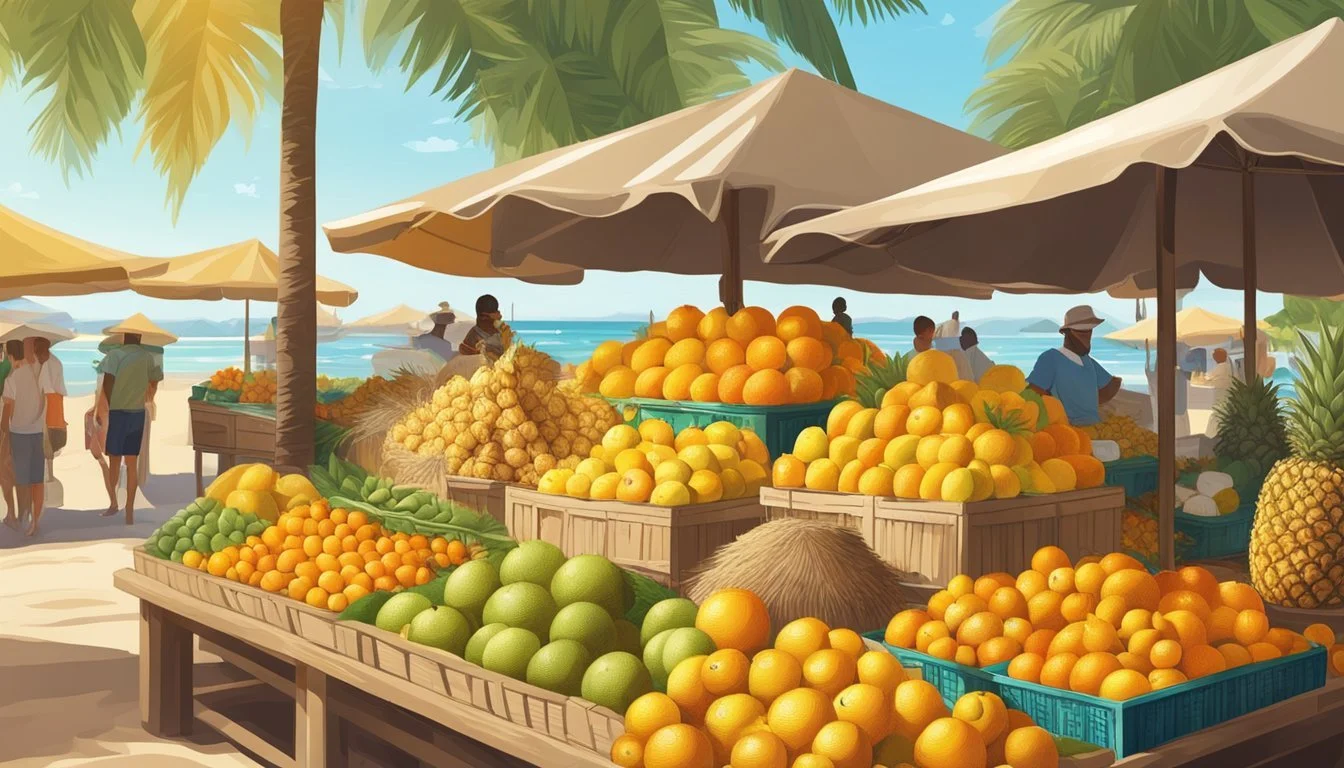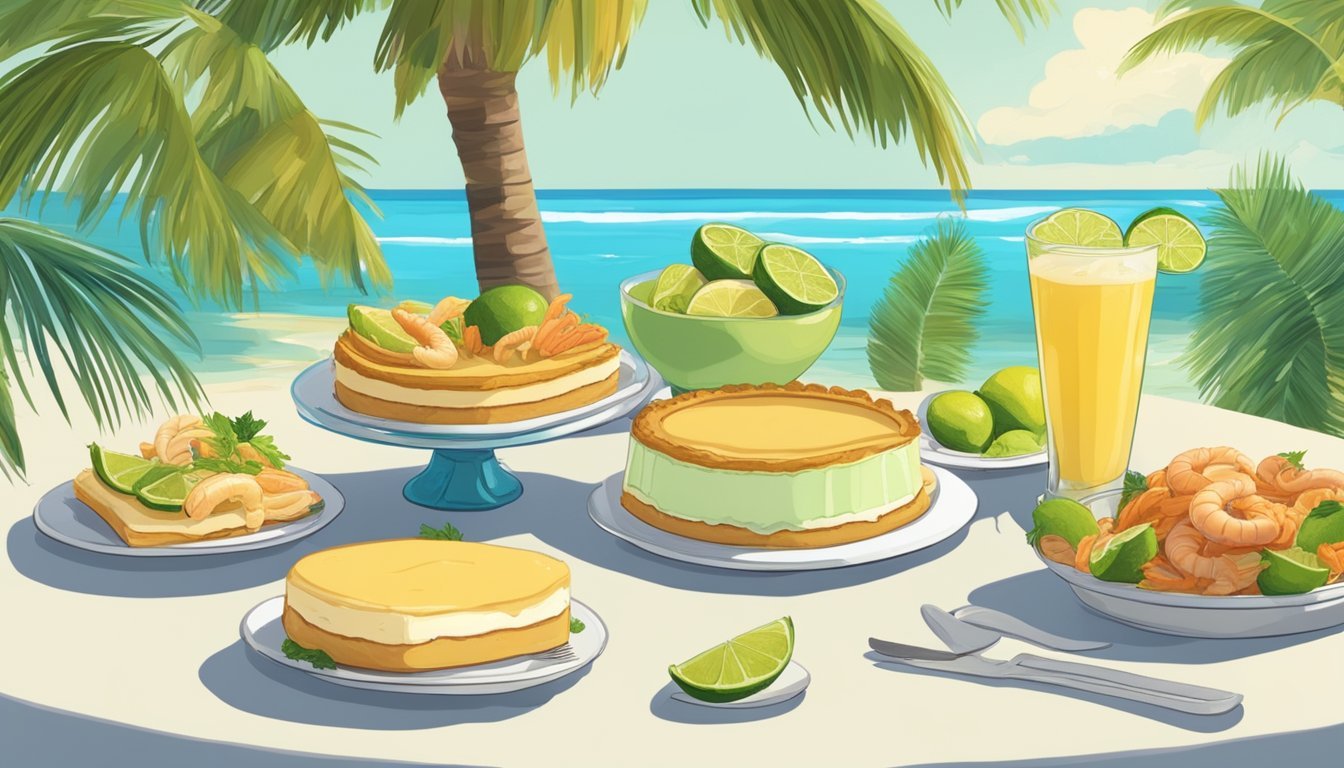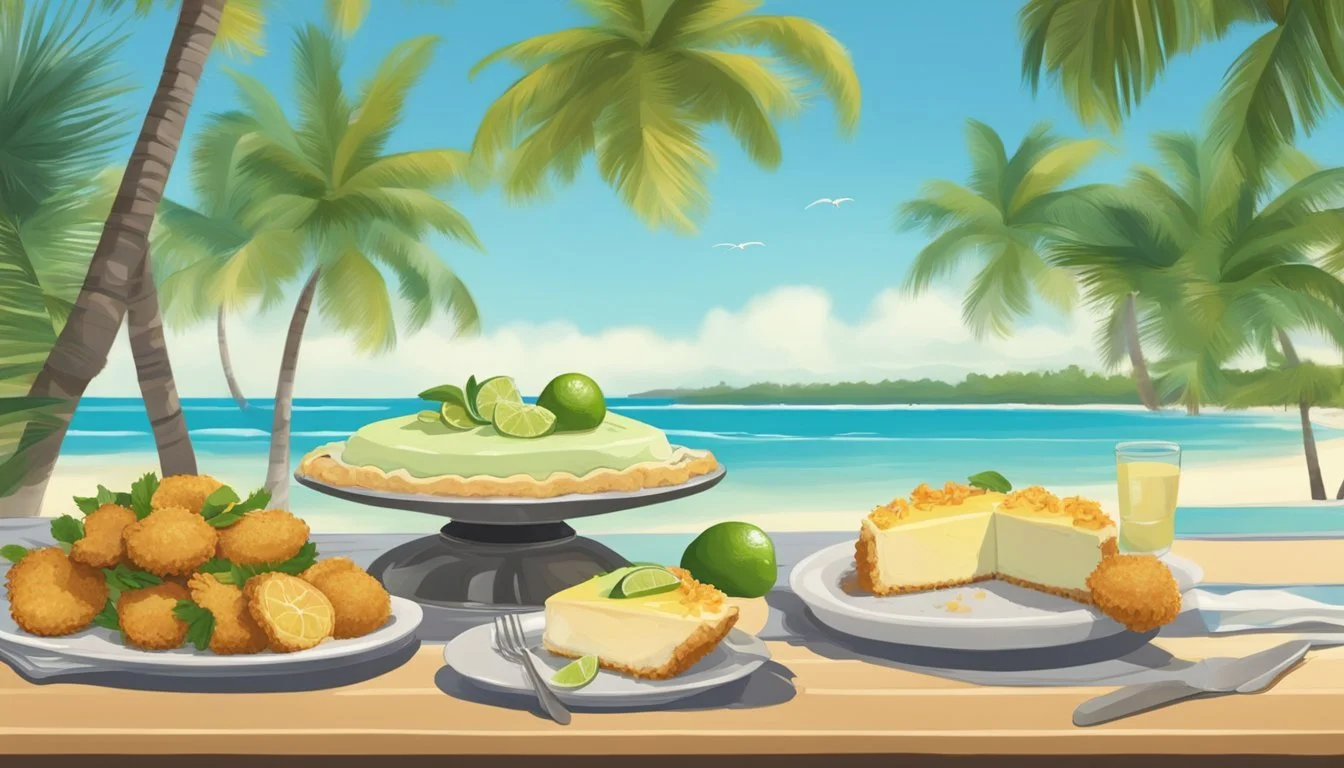What Food Is Florida Known For?
Discovering the Sunshine State's Culinary Delights
Florida, often referred to as the Sunshine State, offers a rich tapestry of culinary delights that reflect its diverse culture and bountiful resources. Its coastal location ensures a steady supply of fresh seafood, which translates into iconic dishes that can be savored throughout the state. Floridian cuisine is a blend of influences—from Southern to Caribbean to Latin—each contributing to the distinct flavors found in the state's gastronomic offerings.
Seafood effortlessly dominates the menu in Florida, with dishes like stone crab (What wine goes well with crab?) served with mustard sauce, and freshly prepared fish tacos featuring local catches such as grouper and mahi-mahi. The state's culinary landscape also enjoys a sprinkle of tropical flair with the incorporation of citrus, found in many dishes and desserts. Key lime pie stands out as a sweet testament to the state's love affair with local fruits.
An interesting facet of Florida's food scene is the Cuban sandwich. A relic of historical migration, it unites ham, roasted pork, Swiss cheese, pickles, and mustard between slices of freshly baked Cuban bread, pressing it all together to create a quintessential Miami favorite. This dish exemplifies how Florida's food scene is not just about ingredients, but also about the stories and traditions of the diverse communities that call the state their home.
Iconic Desserts of Florida
Florida's dessert scene is a reflection of its climate and cultural influences, offering a blend of tropical flavors and traditional Americana. From the distinct tang of Key lime to the sweetness of locally grown strawberries, the state's unique treats are a testament to its culinary creativity.
Key Lime Pie
Key Lime Pie reigns as the quintessential dessert of Florida. It is traditionally made with a simple combination of Key lime juice, egg yolks, and sweetened condensed milk, which gives it a uniquely creamy, tart flavor. The pie typically features a graham cracker crust and is often topped with a layer of whipped cream or meringue. Key lime pie embodies Florida's culininary spirit with its simple yet bold taste profile.
Other Sweet Treats
Beyond Key lime pie, several other desserts capture Florida's essence. Strawberry Shortcake, usually made with fresh Florida strawberries, is a popular item especially when strawberries are in peak season. Another iconic treat is the Dole Whip, a refreshing, pineapple-flavored soft serve found at Walt Disney World, celebrated for its creamy texture and intense pineapple flavor. Local citrus also influences desserts like the Kumquat Pie, hailing from Florida's kumquat capital, Dade City, with its sweet-tart flavor. Other Florida favorites include the rich Orange Crunch Cake and tropical Guanabana Milkshake, both infusing local fruit flavors into classic dessert forms. Whether one has a sweet tooth for pastries or frozen delights, Florida's dessert offerings are as vibrant and diverse as its culture and history.
Seafood Specialties
Florida is renowned for its diverse range of fresh and flavorful seafood that reflects its rich coastal heritage. This section will explore the prominent seafood specialties that have become synonymous with the Sunshine State's culinary identity.
Stone Crab and Accoutrements
Stone Crab claws are a prized delicacy, particularly harvested from the waters of the Gulf coast. During the stone crab season, which runs from mid-October to mid-May, Florida seafood markets and restaurants offer these succulent claws, often served chilled with a side of tangy Mustard Sauce. The Florida Stone Crab is notable for its sweet, tender meat and sustainable fishing practices, as only the claws are harvested before the crabs are returned to the ocean.
Fresh Seafood Varieties
The waters surrounding Florida yield an impressive variety of fish, each with its distinct flavor and texture. Notable among these are the firm and flaky Grouper, the delicate Snapper, and the meaty Mahi-Mahi. These fish are staples in Florida's seafood cuisine and can be found at local seafood markets, with many restaurants showcasing these stars in their dishes.
Oysters and Clams
Apalachicola Oysters (What wine goes well with oysters?) from the Florida Panhandle and Cedar Key Clams (What wine goes well with clams?)from the Gulf coast are two of Florida's shellfish treasures. Oysters are often served raw on the half shell, steamed, or baked, offering a taste of the bay's distinctive briny flavor. Clams, especially from Cedar Key, are celebrated for their sweet taste and are typically steamed or incorporated into sumptuous chowders and pasta dishes.
Unique Seafood Options
In addition to the standard fare, Florida's seas are home to some unique seafood choices. The Conch, transformed into Conch Fritters or conch salad, is a Florida Keys favorite, offering a taste of the Caribbean. While not seafood, Gator Bites, made from farm-raised alligator meat, provide a different taste of Florida's local flavor. Fried conch and gator bites are both must-try items for those seeking the full Floridian experience.
Florida's Cuban Influence
Florida's rich cultural tapestry is significantly colored by its Cuban heritage, particularly in the culinary realm. Cuisine from Cuba reflects the state's vibrant diversity, with Miami serving as a hub for Latin food, characterized by a fusion of flavors and ingredients that emanate from the many Cuban-Americans who call Florida home.
The Cuban Sandwich
One can hardly mention Cuban influence on Florida's food scene without highlighting the famed Cuban sandwich. Often simply referred to as a Cubano, this sandwich is a culinary staple that marries layers of roasted pork, ham, Swiss cheese, pickles, and mustard between slices of crusty Cuban bread. Its widespread popularity across the state is a testament to its delicious and satisfying blend of flavors and textures.
Ingredients:
Roasted Pork
Ham
Swiss Cheese
Pickles
Mustard
Cuban Bread
Other Cuban Delights
Beyond the ubiquitous Cubano, Florida's culinary landscape is dotted with a variety of other Cuban delicacies. Arroz Con Pollo stands as a hearty and comforting dish where chicken and rice are cooked together until they reach perfect harmony. Additionally, empanadas offer a portable feast with their flaky pastries filled with a variety of meats, cheeses, or sweet offerings. These dishes, among others, reflect the influence of Cuban culture, bringing a taste of the Caribbean to the Sunshine State.
Citrus and Tropical Fruits
Florida's reputation for citrus fruits is well-earned, as the state produces a significant portion of the world's oranges, renowned for their quality and taste. Beyond citrus, Florida also offers an array of tropical fruits, thriving in its warm climate along the Gulf Coast and beyond.
Citrus Galore
Florida is synonymous with oranges. In fact, Florida oranges are a staple, making up a considerable volume of America's orange juice supply. The state's warm climate and rich soil contribute to the production of these juicy, vitamin C-packed citrus fruits. Moreover, Persian limes and kumquats are also cultivated extensively, the latter being a smaller fruit that pairs excellently with local food and fresh seafood.
Main Citrus Fruits:
Oranges: Predominant in juice production.
Persian Limes: Integral for culinary uses.
Kumquats: Unique, bite-sized citrus treat.
Exotic Fruit Picks
Alongside the celebrated citrus, Florida is a treasure trove of tropical fruits. These include fruits like avocados and mangoes, which have found a second home in Florida's subtropical climate, cultivating a loyal following for their rich flavors and nutritional benefits. Often found in local markets and making their way into the state's diverse cuisines, these fruits underscore Florida's reputation as a provider of a wide range of fresh, quality produce.
Popular Tropical Fruits:
Avocados: Creamy texture and heart-healthy fats.
Mangoes: Sweet, tangy, and rich in Vitamin C.
Nutrient-rich and integral to the local food scene, these citrus and tropical offerings are cherished not just for their flavors but also for their contributions to the health and economy of the Sunshine State.
Regional Specialties and Styles
Florida's culinary scene is as diverse as its population, boasting a blend of Southern comfort foods, Caribbean-influenced "Floribbean" cuisine, and fresh seafood from the Gulf of Mexico. Each region has its distinct flavors and cooking styles that contribute to the state’s gastronomic tapestry.
Southern Influence
In Florida, Southern food holds a place of pride, especially throughout the inland areas and the panhandle. Barbecue is a prime example of the state's Southern culinary influence, with slow-cooked meats such as pork, brisket, and ribs taking center stage. Sides like collard greens (how long do collard greens last?), cornbread, and black-eyed peas (how long do black-eyed peas last?) round out a traditional Southern meal in Florida.
Floribbean Flavors
Floribbean cuisine is a fusion of Caribbean, Latin American, and Florida cuisines, characterized by bold spices and unique flavor combinations. Dishes often feature fruits like mangoes, papayas, and citrus to complement the seafood and meats. Ceviche, a dish made with fresh raw fish cured in citrus juices, epitomizes the refreshing and innovative spirit of Floribbean cuisine.
A Taste of the Gulf
The Gulf of Mexico's bountiful waters are a treasure trove for seafood lovers. Seafood dishes (What wine goes well with seafood dishes?) here are drawn from a variety of culinary traditions, including Spanish Tapas and Creole flavors. Grouper, shrimp, and oysters are menu staples, commonly served fried, grilled, or in hearty gumbos and stews. The iconic Gulf seafood gumbo is a testament to the region’s love affair with flavorful seafood concoctions.
Fusion and Fine Dining
In South Florida, particularly Miami, the dining scene offers an exquisite blend of cultural tastes and culinary innovation. Renowned for its fusion cuisine, the state incorporates Latin and Caribbean flavors, intertwining them with local produce to create a unique gastronomic experience.
Fine dining establishments across Florida take pride in their innovative offerings. Dishes such as lobster (What wine goes well with lobster?) strudel and homemade lemon ricotta pancakes showcase the creativity chefs employ, marrying unconventional pairings with traditional techniques. These restaurants put a premium on quality, often sourcing ingredients from local farms, emphasizing the freshness in their farm-to-table approach.
Florida restaurants are not just about the blend of flavors; they are also about the presentation and ambiance. Many fine dining venues feature interior designs and views that complement the culinary delights, making the overall experience memorable.
Here is a snapshot of the cuisine spectrum one might explore in Florida's fine dining scene:
Local Seafood Specialties: Freshly caught seafood is a staple, often served fried or infused with zesty citrus flavors.
Diverse Citrus Dishes: Key lime pie remains an iconic dessert, alongside other citrus-based treats.
Fusion Delights: Caribbean spices mingle with Southern cooking, presenting bold flavors in dishes that reflect Florida's melting pot of cultures.
Culinary enthusiasts and diners looking for a sophisticated evening cannot overlook the fusion and fine dining opportunities that Florida offers. The state's innovative culinary scene is something that both locals and visitors continue to savor.
Casual Eats and Street Food
In Florida, the abundance of casual eats reflects the state's rich culinary tapestry influenced by the Atlantic Ocean and a variety of cultures. Street food, with its laid-back flair, captures the essence of Florida's food scene.
Pink Shrimp from the waters around Florida are a must-try. These delicacies are often served fried to a golden crisp, (how long does golden crisp last?) offering a tender and succulent bite. Available at seafood shacks and street food stands, they showcase the local catch from the Atlantic.
For those with adventurous palates, Fried Gator Bites are a unique Floridian street food. These morsels are typically marinated, breaded, and deep-fried, resulting in a texture that's both chewy and crisp. They're a testament to Florida's wild side and are a hit at food festivals and local eateries.
Lobster in Florida is often found in more relaxed settings than one might expect. Food trucks and seaside stalls serve up lobster rolls stuffed with chunks of fresh, sweet meat – a simple yet indulgent treat for diners seeking the flavors of the sea.
Roast Pork is another street food staple, especially within the Cuban-American communities. Marinated and slow-roasted until tender, this savory delight is commonly served in sandwiches (What wine goes well with sandwiches?) or as part of a hearty plate at casual roadside stands.
Though less traditional in the realm of street food, Florida's Atlantic Ocean offers an array of seafood that enhances the casual dining experience. From fish tacos to seafood baskets, the ocean's bounty is a cornerstone of Florida's street food fare.
Here's a taste of what foodies might encounter on Florida's streets:
Seafood: Fried shrimp, lobster rolls, conch fritters
Meat: Cuban roast pork sandwiches, fried gator bites
Specialties: Fish tacos using local catch, diverse influences from Latin America and the Caribbean
This array of casual eats provides a delicious introduction to the Sunshine State's street food scene.
Food Festivals and Events
Florida's vibrant food scene is celebrated through various food festivals and events that attract locals and vacationers alike. These festivals provide a platform to experience the state's culinary diversity and rich local produce.
Key West Food and Wine Festival: This festival is a culinary highlight for both food enthusiasts and wine connoisseurs. It offers a series of events including sunset wine tastings, trolley tours of Key West's prominent kitchens, whiskey tastings, and delightful shrimp boils.
Florida Strawberry Festival: In Plant City, strawberries are the star of the show. Visitors can enjoy fresh strawberries, strawberry-themed foods, and a variety of family-friendly activities, absorbing the essence of Florida’s agricultural traditions.
SeaWorld’s Seven Seas Food Festival: Beyond thrilling rides and marine life exhibits, SeaWorld in Orlando hosts this event featuring a spectrum of dishes and concerts. Participants get a taste of international cuisines alongside performances from artists like Vanilla Ice and Flo Rida.
In the cooler months, the Epcot International Food & Wine Festival presents an immersive experience with global cuisine, interactive workshops, and live entertainment, making it an essential stop for Disney visitors.
Furthermore, Florida serves as the nation's winter salad bowl, and its abundant local produce is on full display at numerous regional festivals across the state. These events provide a peek into Florida’s fishing heritage by showcasing fresh seafood and traditional fishing practices. From the Panhandle to the Keys, one can find exciting things to do and explore the state's food traditions through local events and food festivals.
Agriculture and Fishing Industries
Florida's landscape supports a robust agriculture sector, famous not only for citrus fruits but also for vegetables like tomatoes, and an impressive fishing industry that produces a significant portion of the nation's seafood.
Fishing Communities
In Florida, fishing drives local economies, especially in areas like Tarpon Springs, where Greek heritage influences the local food scene. Tarpon Springs has a rich history of sponge diving and is notable for seafood dishes, particularly the Greek Salad of Tarpon Springs, which is a local culinary highlight. Fishing in Florida is a year-round industry, contributing significantly to the state's income with a variety of species ranging from shrimp to spiny lobster.
Fruit Harvests
Florida's fruit harvests are a cornerstone of its agricultural output, with the state being a leading producer of oranges and grapefruits. In Central Florida, often labeled the "Winter Strawberry Capital," the perfect climate and soil conditions lead to the annual harvest of abundant and sweet strawberries. The kumquat, a small, tart citrus fruit, also finds a unique niche in Florida's agriculture, with the region around Dade City known as the Kumquat Capital.
Historical Cuisine and Stories
Florida's historical cuisine is a rich tapestry woven from various cultural threads, among the most pronounced being Spanish influence and Minorcan traditions. These elements hold specific significance in places like St. Augustine, giving a distinct identity to Florida's culinary history.
Spanish Influence
When the Spanish explorer Ponce de León landed in Florida in 1513, he introduced not only Spain’s claim to the region but also its culinary staples. Oranges, now emblematic of Florida, were originally brought over by these early Spanish settlers. Although not native, oranges have become deeply integrated into Florida’s food scene and are a key part of its agricultural economy.
Minorcan Traditions
Arriving in the late 18th century, Minorcans settled in St. Augustine and brought with them their robust flavors and hearty dishes. Among their lasting culinary contributions is the Minorcan clam chowder, distinguished by the potent local datil pepper. This chowder varies from its New England and Manhattan counterparts by exhibiting a spicier profile, nodding to the deep roots that Minorcan culture has implanted in Florida’s culinary soil.
Tourism and Dining
Florida's tourism industry is intrinsically linked to its dining experience, attracting visitors with a fusion of flavors that reflect the state's diverse culture and abundant resources. Disney World, a prime tourist destination, not only offers a magical experience but also a vast array of dining options, from themed restaurants to global cuisine, catering to visitors from all over the world.
Beaches across Florida serve as stunning backdrops for waterfront dining. Restaurants dotting the coast, particularly in areas like Naples, provide exquisite seafood dishes—like stone crab or fish tacos—crafted from the fresh catch of the day. These sunny locales blend vacation relaxation with culinary delight.
Florida Highlights Description Disney World Dining A myriad of eateries featuring global and local flavors. Beachfront Restaurants Seafood-centric menus with ocean views. Naples Upscale dining with a focus on fresh, local ingredients.
Visitors on vacation often indulge in the Floridian cuisine, which boasts unique traits setting it apart from traditional Southern food. This includes a mix of Southern, Latin, and Caribbean influences, often referred to as Floribbean cuisine. They also savor the state's famous citrus in various forms, from fresh-squeezed juices to zesty flavorings in dishes.
Dining in Florida is not just about sustenance; it's an essential part of the tourism experience. It offers something for every palate, whether they're seeking innovative food experiences or familiar comfort dishes in a new setting. Florida's culinary scene continues to grow, drawing food enthusiasts to its shores year after year.
Sourcing and Sustainability
Florida's food landscape is rich with an array of local foods, known for both their quality and the state's commitment to sustainable practices. Key players within the industry have pioneered efforts to support and develop a resilient food system that emphasizes sustainable dining and responsible sourcing.
Local Food: Florida's culinary scene boasts an abundant variety of local foods that have become synonymous with the state. Citrus fruits, seafood, and sugar are some of the staple foods produced locally. Farmers and vendors prioritize sustainability by implementing modern technologies that reduce environmental impacts and enhance resource efficiency.
Sustainable Dining: Restaurants across the state are increasingly adopting sustainable dining practices. They often source ingredients from local suppliers to ensure freshness and support the local economy. Additionally, many dining establishments actively participate in waste reduction programs and promote plant-based menus, which reduce the carbon footprint associated with food production.
Sustainability Initiatives:
Local Sourcing: Restaurants prioritize ingredients grown within the state to ensure support for local producers and reduce transportation emissions.
Waste Reduction: Establishments engage in recycling and composting programs to minimize food waste.
Transparent Supply Chains: Many Florida food companies adhere to transparent sourcing, ensuring that both seafood ingredients and food-contact packaging are traceable.
By centering sustainability in its sourcing methods, Florida not only protects its rich agricultural heritage but also sets an exemplary standard for other states to follow. The emphasis on sustainable food sourcing reflects a broader commitment to environmental stewardship and positions Florida at the forefront of a global movement towards sustainable food systems.
Food Culture and Identity
Florida's food scene is an eclectic tapestry woven from its diverse cultural heritage and coastal bounty, reflecting the state's identity through its unique culinary offerings.
The Melting Pot of Florida
Florida's culinary identity is largely influenced by its Cultural Diversity, where Hispanic, Caribbean, and Southern American flavors merge. In cities like Miami and Tampa, Cuban and Puerto Rican cuisines stand out with dishes such as roasted pork and salami featured in the famous Cuban sandwich. These communities have ingrained their food traditions so deeply into Florida Culture that they've become representative of the state itself.
Tastes of Northern Florida
Drawn from its geographical proximity to Georgia and its historical ties, Northern Florida boasts Southern-inspired comfort foods. This region's identity is often associated with smoky barbecues and sweet pecan pies. True to the food culture of the South, one may find smoked meats and fresh catch from the local waters served alongside hearty sides.
Florida's West Coast Gems
The Gulf Coast of Florida is celebrated for its seafood, with Stone Crab Claws as a notable delicacy. Harvested primarily from the Gulf waters, these claws are often cracked and served with a signature mustard sauce. The Gulf Coast's identity is also characterized by a variety of seafood dishes, including gumbo—a testament to the region's love for flavors that speak of both the sea and the blending of cultural histories.









